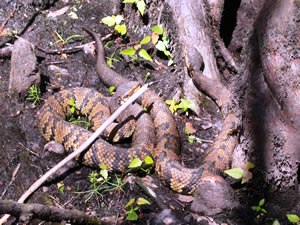Reproduction
Throughout the great journey that is life, reproduction is a necessity. For the Western Cottonmouth, reproduction begins with a sort of mating call except in this case the call is more of a dance. The “combat dance” occurs when the male cottonmouth swims (if in water) or slither (if on land) back and forth while waiving the tail to lure any potential female in the area away from any other females. The male snakes sometimes will compete by actual combat for the right to mate with the snake in question. The breeding period then can continue with the male and female, all of which occurs during the spring, with some cases observing even a late summer mating period.
Following the spring courtship and actions of reproduction, the female observes a gestation period of 160 to 170 days or roughly 5 months. During this period the female contains the eggs within the snake’s anatomy. During this period of pregnancy, it has been theorized that the female snakes do not feed (see nutrition), but little data exists in literature on the subject. Hatching of the eggs occurs between the months of August and October. Between three to twelve offspring, and even as many as sixteen offspring, have been reported in some cases. These juveniles are born six to eleven inches long and a distinguishable yellow tip of the tail. At the time of birth, the juveniles have a fully developed set of fangs complete with a full supply of hemotoxic venom. But prior to the birth of the juveniles, the eggs that the baby snakes are contained in are hatched within the mother (this is called ovoviviparity), so that the young come out of the mama snake alive and kickin' (well really squirming).
The life of the juvenile will continue with the basics, finding food and growing until the age of two for the males, at which point they become sexually mature. The same happens for females but sexual maturity occurs after three years. Then the cycle begins again.
The combat dance of the Western Cottonmouth is a courtship ritual that has been noticed through the 20th century but never taken into account that it was a form of courtship. The first observance recorded in literature was in the mid 1930s and 40s when scientists Davis (1936), Carr and Carr (1942) and Gloyd (1947) discovered the same type of dance both in the wild and also in captivity of the crotalids (subfamily of Vipers, commonly called pit vipers, see classification). All three groups of scientists believed that this “dance” was a prelude to sexual reproduction, but the sexual identity of the snakes was never determined. Another scientist by the name of Lowe (1942) concluded something different when he noticed the same dance in a pair of red diamond rattlesnakes (Crotalus ruber); he assumed it was a courtship dance as people before him had concluded. But, unlike the previous scientists, Lowe sexed both snakes and found them to be both males. Lowe then concluded in 1948 that the dance he observed was not a courtship dance but a dance of territorial behavior between the two males. In the same year (1948), Shaw theorized that the behavior between the two males could be a type of “combat dance”. Again in that same year, Ramsey observed the same behavior in the Western Cottonmouth (Agkistrodon piscivorous leucostoma). Finally in 1948, Lowe and Shaw both observed the aggressive behavior between two male similar to all of the observations previously stated except that the snakes at several points went to the extreme of biting, savagely, each other. Lowe and Shaw concluded finally, that the behavior involved three cases of competition including territorial, social domination, and sexual domination. Also upon conclusion, they found that this dance could be involved in the testing of sexual readiness to mate in the male.
Advance forward comrades to enhance your knowledge of the Western Cottonmouth in the adaptation section.


